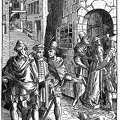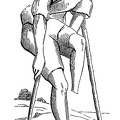Originally, decapitation was indiscriminately inflicted on all criminals condemned to death; at a later period, however, it became the particular privilege of the nobility, who submitted to it without any feeling of degradation. The victim--unless the sentence prescribed that he should be blindfolded as an ignominious aggravation of the penalty--was allowed to choose whether he would have his eyes covered or not. He knelt down on the scaffold, placed his head on the block, and gave himself up to the executioner. The skill of the executioner was generally such that the head was almost invariably severed from the body at the first blow. Nevertheless, skill and practice at times failed, for cases are on record where as many as eleven blows were dealt, and at times it happened that the sword broke.
Public Executions.--Fac-simile of a Woodcut in the Latin Work of J. Millaeus, "Praxis Criminis Persequendi:" small folio, Parisis, Simon de Colines, 1541.
- Author
- The Project Gutenberg EBook of Manners, Custom and Dress During the Middle Ages and During the Renaissance Period, by Paul Lacroix
- Posted on
- Thursday 12 March 2020
- Dimensions
- 1352*1902
- Tags
- Crime, Death, Punishment
- Visits
- 1592
- Downloads
- 54
 Download Photo
Download Photo





